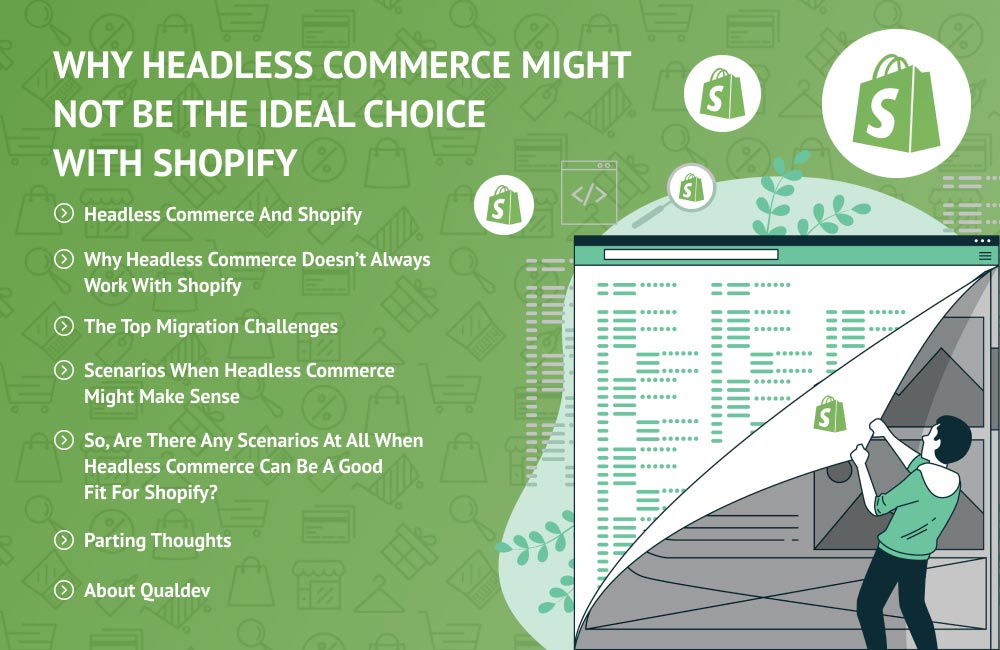In the business world, we often talk about “staying one step ahead” without really strategizing exactly how to do it. While this is applicable as a blanket statement for all business, it is particularly relevant for those who wish to offer an exceptional digital shopping experience to their customers. Headless commerce, in that sense, has become the go-to choice for online stores because this type of architecture offers a massive range of benefits.
However, it might not necessarily be the right fit for each and every Shopify store. Let us delve into why this is the case. In this article, we will discuss:
Headless commerce and Shopify
In a typical headless commerce setup for Shopify, you basically utilize the latter’s backend features and data architecture and let go of the control over your frontend functionality and UI. Headless commerce enables you to rely on customized frontend development (which is decoupled from the backend platform) by using JavaScript frameworks.
- Shopify and headless commerce
- Why headless commerce doesn’t always work with Shopify
- The top migration challenges
- Scenarios when headless commerce might make sense
Why doesn’t headless commerce always work with Shopify?
Here are the top reasons why we think headless commerce may not always be the right fit for all Shopify stores:
1. Well, for starters, you stand to lose a lot of the inherent benefits that the platform offers. Since you decouple the frontend and the backend, you can no longer leverage the great flexibility that Shopify’s themes are known for and neither can you take advantage of its CMS-based editor. This essentially means that you are left with the arduous task of managing the complex frontend elements by yourself or via a full-time developer.
2. Building upon point number one above, you also do away with the option of integrating third-party applications. Shopify is known for its wide-ranging ecosystem that allows you to pick and choose relevant apps for your needs, but you relinquish the choice to leverage these ready-to-use apps, thus forgoing an easy and seamless option. Instead, you are left relying on custom development for every single need, which may limit your capabilities and increase the amount of time and manual effort in a headless setup.
3. Money is another big consideration here – in spite of decoupling the frontend and the backend, you are still liable to pay Shopify the predefined transaction charges. And any kind of custom development (hosting, managing, and adding frontend tools or new functionalities) is likely to incur separate costs.
The other critical factor to consider is that unless you have the Shopify Plus plan, you will be restricted in terms of the flexibility and customization options, especially in terms of the checkout.
A look at the migration challenges
Moving to a headless setup is a complex process because of the structural inconsistencies and data migration differences between Shopify and custom solutions. These complexities can directly affect your other processes, including product identification and third-party marketplace integration.
Take into account the longer turnaround times and high costs involved in building your frontend and backend functionalities from scratch and you have yourself a bad headache!
It is a mix of all of these factors that make headless commerce and Shopify a recipe for disaster, especially for smaller businesses or those that have limited budgets.
So, are there any scenarios at all when headless commerce can be a good fit for Shopify?
Yes, there are. While it may not be a match made in heaven, there certainly are scenarios when this partnership makes sense. For example, if URL structure freedom is the most important thing for you, a headless architecture can easily accommodate your specific needs.
Another example would be a scenario where you want to focus on delivering omnichannel experiences and easy integration across a variety of apps, eCommerce stores, websites, and platforms – this is where a headless setup can really come into its own and deliver a seamless experience.
Parting thoughts
To conclude, while headless commerce has a huge range of benefits that you definitely cannot just overlook, it is important that you do a self-assessment and consult a specialist to analyze whether its integration and implementation with Shopify makes sense for you.
If features, functionality, seamlessness, and quick turnarounds matter to you more than anything else, it might be better for you not to take the headless route. A hybrid approach or a custom approach might work better in this case, since it allows you to be flexible and nimble, saving costs and time in the process. Leverage the power of Shopify and headless commerce with Qualdev – a web development company with an illustrious track record.
About Qualdev
As a leading Shopify web development company, Qualdev can assist you in setting up the best theme for your site from the Shopify theme store. We will support you in choosing the best theme for your site, installing it, and personalizing it with your content.
Our expert team can also work with you to construct that perfect custom design, taking your brand identity into account. If you have an existing store but need some help with some particular functionality, integration with third-party apps, improving the look-and-feel, or bringing your Shopify store to the final step in your vision or helping increase sales—Qualdev can help! Explore our solutions and get in touch with our team today.

